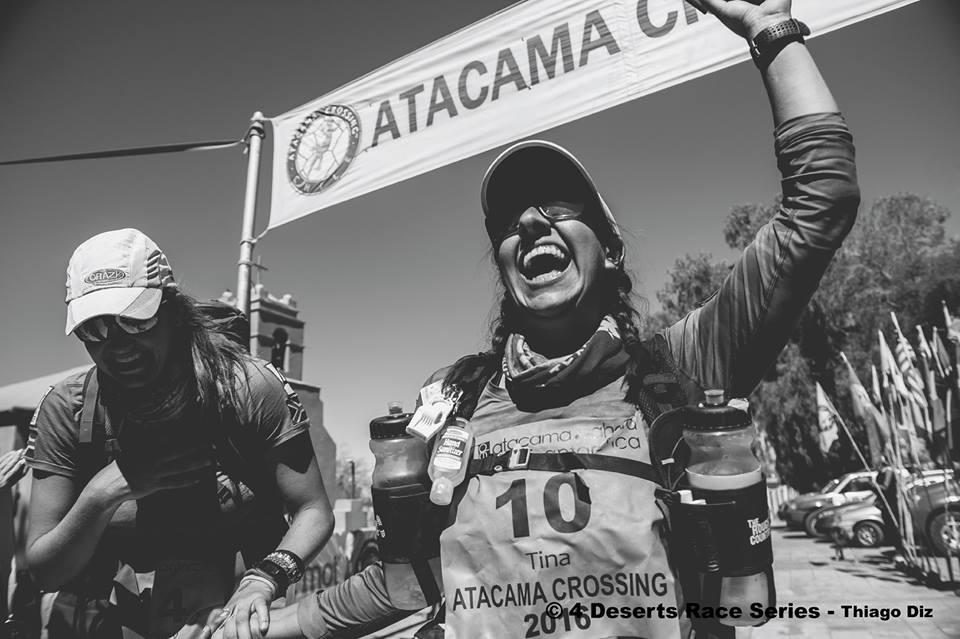
26 Feb Shelley Bolle on crossing the Atacama & the eco staples that saw her through
Human beings are wonderful, crazy, curious creatures that will put their bodies through all sorts of gruelling experiences for the sheer purpose of seeing whether we can, of pushing through to a new level of self and of finding those elusive pockets in life between agony and pure nirvana that make it all so crystalising, so beautiful, pure and worth it.
We asked Shelley Bolle, running enthusiast, to share her recent journey of high performance endurance with us in crossing the Atacama, some insights and top supplement picks for endurance athletes.
What is the Atacama Crossing? It’s a 250 km foot race through the Atacama Desert (the driest desert in the world) over 6 stages/7 days. The race is self-supported, meaning all your belongings for the week are carried on your back, in a pack.
So, what do you need to bring? The mandatory equipment list is 6 pages long, which includes the usual medical kit, emergency items and all your food for the week (minimum of 14000 calories, which is enough sustenance, IMHO, for a 3-year-old). Drinking water is all provided for you throughout the course, and hot water in the mornings and evenings (to make your porridge and freeze-dried meal that day).
Sleeping quarters consist of a big round tee-pee type style tent with a thin groundsheet, but you must bring your own sleeping bag (and sleeping mat, if you want to add that weight to your pack!) – not to mention your “luxuries” such as a toothbrush and iPod!
With extreme temperatures, long distances and being exposed to the harsh elements, this is one helluva challenge. The first 4 days are “easy” distances, no more than 44 km, and then day 5/stage 5 is known as “the long march” at 77 km, which then runs into day 6. The last day is a quick 8km “sprint” to the finish line in the picturesque town of San Pedro.

What did the Atacama crossing reveal to me?
The crossing of the Atacama wasn’t what I expected. I knew it would be tough, but not THAT tough. I knew I’d make friends, but I didn’t expect to make the kinds of connections I did. For me, so much of it was about the people. I met the most incredible people from all over the world.
I formed bonds that I didn’t think would be possible to form in just a week. 43 nationalities, 1 crazy family! I was also (pleasantly) surprised that my race was hugely social – almost more so, than physical.
The hardest part was the mental space. After a while, your physical space becomes kind of expected. Almost like your body was like “oh okay, we’re running through a desert, rad” and goes on auto pilot. Mentally you’ve got to stay determined and driven and focused and positive. It’s hard to do that when you’re exhausted and scared and in pain. The Ashwaganda is GREAT for this. Although it is more a recovery type powder, it had such an effect on my emotional state, acting almost like a natural anxiety medication.

Other mentionable noteworthies of my running experience
- Proudly being part of ‘the loud tent’ also known as the Motley Crew
- Struggling with altitude (like a leprechaun sitting on my chest and lungs bursting at a min pace) as well as roling over on my bad ankle with the first 2 km
- Running the ‘Inca Road’, also referred to as ‘the oven’ over the hottest part of day 1, solo, initially having thought it would only be 3 km when it was really 9 km, and nearly suffering from ‘canyon fever’
- Day 4 running across the salt flats saw me experiencing what first started as sun spots in my eyes and super fatigued – then I saw a murder of crows and literally ducked, holding my head, only to realise there were in fact, no crows. That was pretty scary, so I quickly took some electrolytes and hustled to the next check point.
- And on the final day – the magic of walking through the Valley of the Moon at 2 am. At this time, I was an hour from finishing, and I had the most profound feeling of peace and satisfaction. I knew I’d done it – nothing could stop me now. The feet, the hip, the fatigue, the hunger, my general physical health – nothing short of a natural disaster was going to stop me. The stars were unbelievable, pretty much along the whole course, but Valle de la Luna was just incredible. I felt like I could have lassoed the stars and even though it was a new moon, it was a clear as I’d ever seen it. To wax lyrical, I felt electric, like my world was new and open, and on my lips was the taste of opportunity and possibility.
The highlight was definitely the connections I made, the scenery and the feeling of accomplishment on completion!
- Badger Cooling Ointment – great and nifty size
- Arnica tablets – took these 3x day to help with overused muscles and inflammation
- Maca root – adaptogen for stress and blood oxygenation, REALLY helped with the altitude – I didn’t suffer a stitch of altitude sickness
- Ashwaganda powder – adaptogen for emotional, physical and mental stress
- Coconut water – used this a lot for training but didn’t take it along with me – superb for hydration
Plan ahead and speak to others who have done it, the more prepared you are, the better. It’s a massive challenge and any prior planning you can do will count in your favour!
And lastly I wish anyone considering it the best of luck – it’s wonderful, it’s torturous and it will profoundly change you for the better.



No Comments